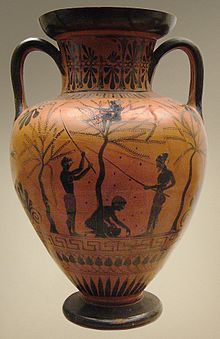


The Antimenes Painter was an Attic vase painter of the black-figure style, active between circa 530 and 510 BC.
The real name of the Antimenes Painter is not known; his current name is an archaeological convention, derived from the Kalos inscription on a hydria in the archaeological museum of Leyden. Of the 150 works ascribed to him, the majority are hydriai and standard amphorae. Most works attributed to him were found in Etruria. He is considered to have been connected with the workshop of Andokides.
He depicted the current repertoire of his period: the adventures of Herakles, Dionysos and his companions, and chariot scenes. He varies the themes, his compositions are described as organised. His distinctive motifs are rather idyllic, often including smaller figurines subsidiary to the main narrative. Examples are a well scene on the aforementioned Leyden hydria and a depiction of the olive harvest on an amphora in the British Museum at London.
His drawing style resembles that of Psiax; influences by the early red-figure style are also apparent. Nonetheless, he continued to use the black-figure technique, which maintained many followers. It is hard to distinguish him and associated painters from the Antimenes Painter. Some examples of his later works are striking in the fine and expressive quality of the drawing.
See also
Bibliography
- John Boardman: Schwarzfigurige Vasen aus Athen. Ein Handbuch, Mainz 1977, ISBN 3-8053-0233-9, p. 119f.
- Johannes Burow: Der Antimenesmaler, von Zabern, Mainz 1990 (Forschungen zur antiken Keramik Reihe II: Kerameus. Band 7) ISBN 3-8053-1029-3
- The Getty Museum – Biography of the Antimenes Painter
- Johannes Burow. Der Antimenesmaler. Mainz: Philipp von Zabern, 1989 (Forschungen zur antiken Keramik. Reihe 2, Kerameus. Bd. 7). ISBN 3-8053-1029-3
References
- The Getty Museum – Biography of the Antimenes Painter The Antimenes Painter decorated vases in the black-figure technique in Athens from about 530 to 510 B.C. Working in a period when many artists were switching to the new red-figure technique, the Antimenes Painter was one of the most prolific black-figure artists of his time. Over 140 of his vases survive, mostly amphorae and hydriai. He decorated his vases with a wide range of mythological and genre scenes but seems to have favored two themes: the hero Herakles and fountain-house scenes. As with most ancient artists, the true name of the Antimenes Painter is unknown; he is identified only by the stylistic traits of his work. Scholars named him after a kalos inscription praising the youth Antimenes on a vase now in the Rijksmuseum in Leiden.
- John Davidson Beazley (1951). The Development of Attic Black-figure. University of California Press. pp. 19–. ISBN 978-0-520-05593-3.
External links
- Antimenes Painter in the German National Library catalogue